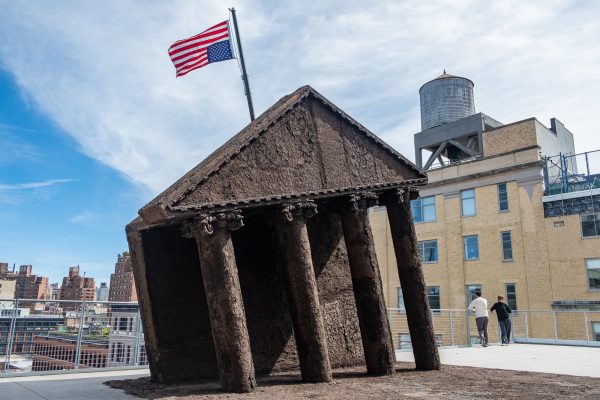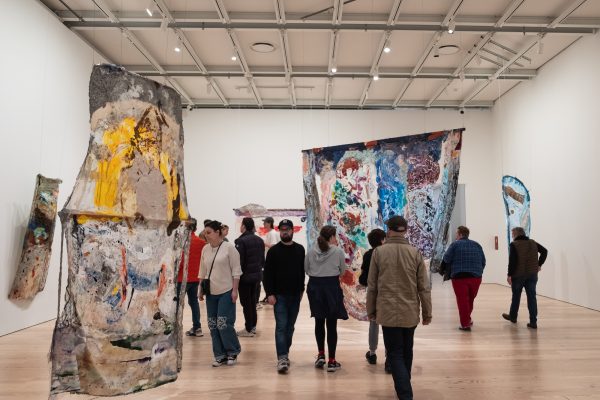From a piano playing itself in a dark room to pastel buoys suspended over a pile of rope and lobster traps, the 81st Whitney Biennial: Even Better Than the Real Thing invites viewers into the innovative minds of contemporary artists.
The Whitney Biennial, which occurs every two years at the Whitney Museum of American Art, is a grand exhibition of contemporary American art of all mediums. This year’s Biennial features the work of 71 artists and collectives. Displayed throughout the museum’s first, third, fifth and sixth floors, the artworks in the exhibition examine the idea of “the real” through explorations of artificial intelligence, gender and bodily autonomy.
Visual artist Carmen Winant’s “The last safe abortion” is a gallery wall featuring 2,500 prints that the artist had gathered over the past 50 years, comprising images from health clinics and hospitals. The artwork includes photographs of patients, health care workers, Planned Parenthood clinics and more. Particularly gripping is a seemingly old photo of a protester carrying a sign that reads the following: “My mom had an illegal abortion. I don’t miss the baby. I miss my mom.” Winant’s decades-old photographs highlight the ongoing fight for reproductive rights, and this visibility of the cause is particularly important after the U.S. Supreme Court overturned Roe v. Wade in 2022.

On the sixth-floor balcony of the museum, overlooking Manhattan’s Meatpacking District, Kiyan Williams’ sculptures offer commentary on contemporary politics in the United States. “The Earth Swallows the Master’s House,” also called “Ruins of Empire II,” is a model of the front of the White House made out of dirt. The structure is crumbling down and at the top of the work flies an upside-down American flag. On the corner of the terrace is Williams’ aluminum “Statue of Freedom,” which is a large sculpture of LGBTQ+ activist Marsha P. Johnson. She watches the building turn to ruins while holding a cigarette and a sign which reads “POWER TO THE PEOPLE.”

Both Williams’ and Winant’s works comment on the current state of the nation, highlighting marginalized groups and how it feels to be a part of movements for justice.
Such poignant visual statements on current affairs would not be possible without the works of contemporary artists. Contemporary art is often brushed aside, as it is unconventional and aims to stretch the boundaries of what traditionally is considered to be art, leaving a majority of today’s experimental artists out of the historical canon. This is why it is so important that the Whitney uplifts today’s creatives. It is refreshing to see an exhibition of works made by people who are currently alive and thriving in the arts, not only those whose times have passed and left their vision behind.
Contemporary art is not only an exploration of the current aspects of society that need to be improved, but shows different and modern ways of creating. American visual artist Suzanne Jackson’s paintings are made without a canvas, suspended from the ceiling. Jackson builds up layers of colorful acrylic paint to create an abstract work whose structure supports itself.

“Even Better Than the Real Thing” is a unique testament to what it means to live in a modern world. Though the world can oftentimes feel intimidating — as seen through Winant’s collection of pieces on reproductive rights — it also serves as a great opportunity for creative exploration. As we see these artists pushing the limits of what it takes for something to be art, we can recognize the excitement of life at a time of such a quickly evolving artistic landscape.
It’s a wonder how the curators managed to set up the space so fluidly. Though the sheer size of the Whitney almost always makes for a smooth viewing experience, the amount of works on display at the Biennial do not feel overwhelming to view, but rather exciting. It is important to note that the exhibition is wildly popular and can easily get crowded. I recommend taking advantage of the museum’s 20-minute walk from campus and going on a weekday during an off-time in order to avoid the crowds. There’s a lot to see, so take the time to explore and enjoy the creativity of today’s artists.
“Even Better Than the Real Thing” will be open at the Whitney through Aug. 11, and admission to the museum is free for NYU students.
Contact Alexa Donovan at [email protected].

























































































































































